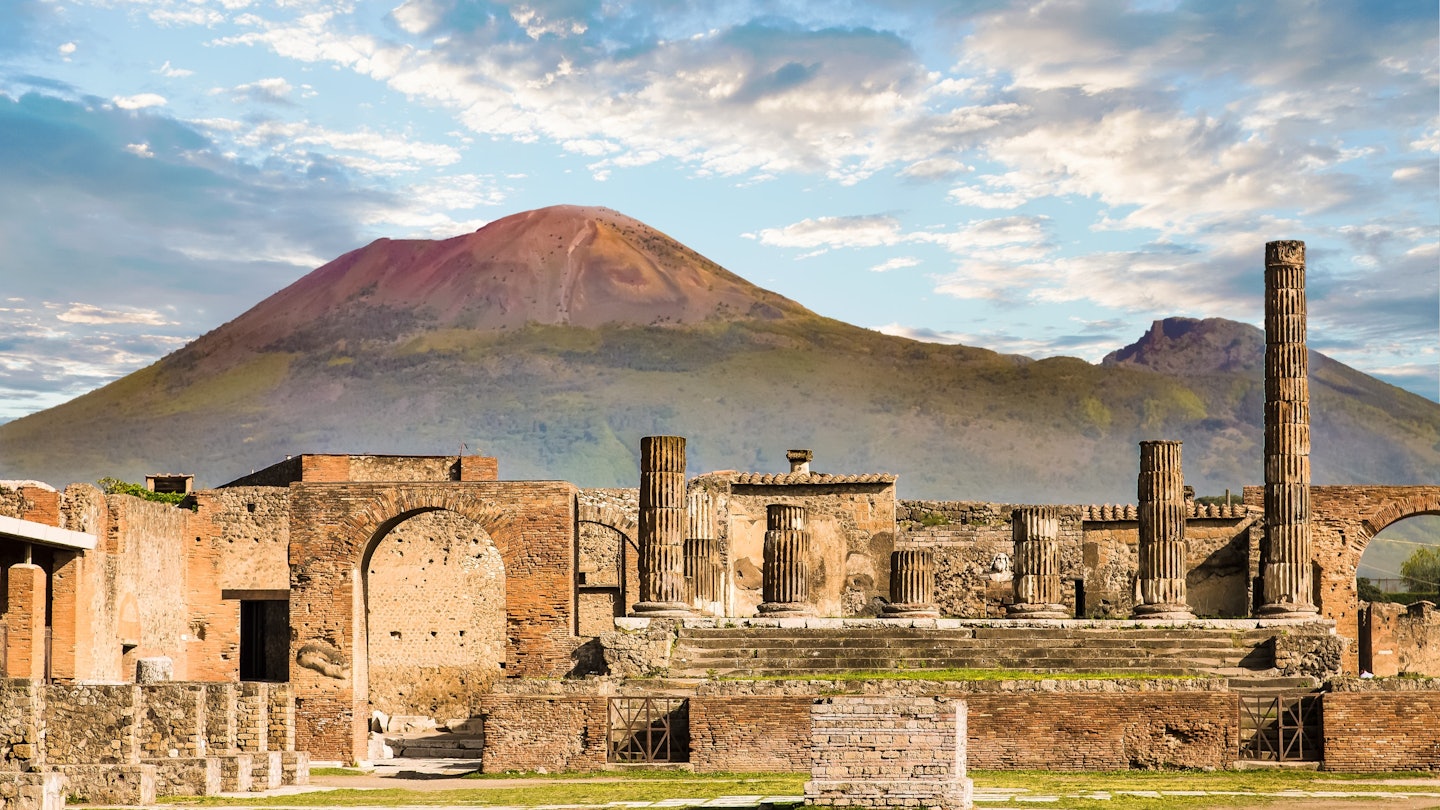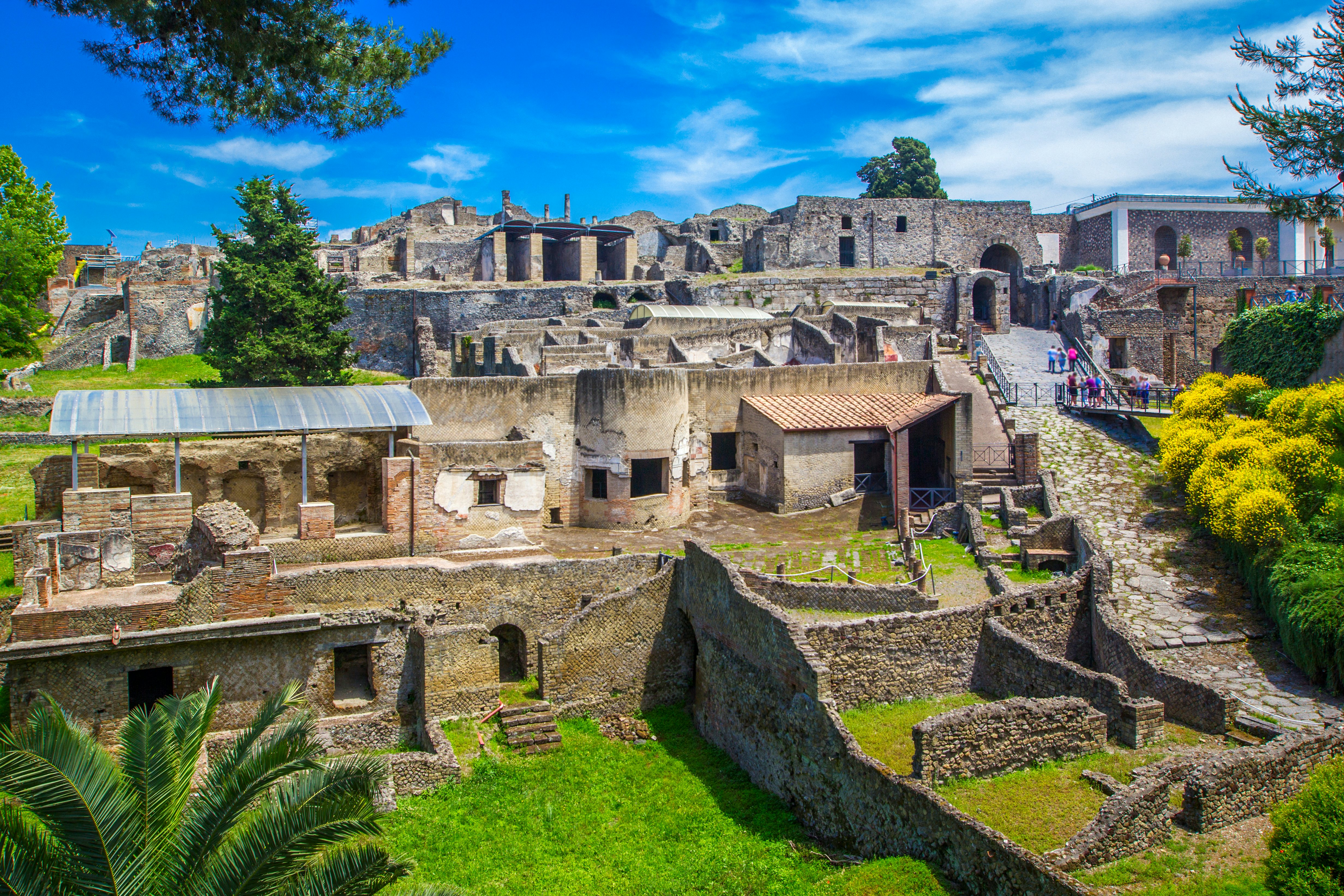
A first-time guide to Pompeii, Europe's most compelling archaeological site

Feb 11, 2025 • 8 min read

Mt Vesuvius, near Naples, looms over the ruins of the ancient city of Pompeii. dbvirago/Getty Images
Pompeii – the mere word conjures spine-chilling scenes of apocalyptic skies and frantic, panicked streets. Despite the passing of nearly 2000 years since Mt Vesuvius’ fateful eruption in 79 CE, this catastrophic disaster continues to grip the world’s imagination. Ironically, what makes Pompeii most intriguing today is not its destruction but its fortuitous preservation. Here, chariot-grooved streets lead to once-bustling squares, stores, baths, theaters and the fabulously frescoed villas of Pompeiian VIPs. Together, they offer an unparalleled glimpse into a world frozen in the midst of its final moments. For first-time visitors, the following guide will set you up for an unforgettable visit.
When should I go to Pompeii?
Pompeii is engrossing year-round, but May and September are the sweet spots. Crowds are manageable and the weather idyllic for exploring both the ruins and the nearby Amalfi Coast. May is also a great time to visit Naples, with its month-long cultural festival, Maggio dei Monumenti.
Pompeii is at its hottest and busiest in summer (June to August). Shade is limited, and the relentless sun can make it a tough experience for some. As this is high season across much of Italy, accommodation is scarce and pricey, so book well ahead.
From November to March, Pompeii sees fewer crowds (with the exception of Christmas holidays), and while the weather can be chilly, the quieter atmosphere offers a more tranquil experience. Year-round, expect large crowds on the first Sunday of the month when entry is free for all.

How much time should I spend in Pompeii?
You’ll need at least three to four hours for a general overview of the park, but it’s worth dedicating a whole day to explore in more detail. If you’re short on time, opt for an afternoon visit and enter from Piazza Anfiteatro, working your way toward the Forum rather than the other way around – it’s cooler, and you’re less likely to hit a crush of large groups.
Is it easy to get in and around Pompeii?
The easiest way to reach Pompeii’s scavi (ruins) is by train. From Napoli Garibaldi train station, Sorrento-bound Circumvesuviana commuter trains take around 40 minutes to reach Pompei Scavi–Villa dei Misteri station, located a short walk from the park’s main Porta Marina entrance. Journey time from Sorrento is around 30 minutes. The Campania Express tourist train also operates on this line, with limited stops including Pompei Scavi–Villa dei Misteri. This said, the little time saved isn’t worth the significantly higher ticket price.
By car, the ruins are about a 30-minute drive from Naples or Sorrento, depending on traffic. Car parks are clearly marked and vigorously touted. Close to the quieter Piazza Anfiteatro entrance, Parcheggio Santuario di Pompei offers excellent-value, all-day parking (€2/US$2.07).
The ruins themselves are explorable on foot and include a decently sized itinerary for visitors with limited mobility.

Top things to do in Pompeii
Pompeii abounds with rare archaeological treasures. If you’re a first-time visitor, add the following to your hit list.
Applaud gladiators and music icons at the Amphitheater
Pompeii’s 70 BCE anfiteatro (amphitheater) once thundered with the roars of thousands as gladiators and wild animals clashed in bloody combat. You can still spot frescoes depicting gladiatorial battles on the parapet, as well as the rings used to secure the velarium (canopy) that shielded spectators from rain or beating sun. In June and July, the amphitheater hosts a series of concerts featuring world-renowned music acts.
Explore the heart of a classical downtown
The Foro (Forum) delivers Pompeii’s money shot, with towering temple columns and nemesis Mt Vesuvius looming in the background. This square was the town’s epicenter of political, spiritual and commercial life, and its ruins include the most significant of Pompeii’s religious buildings: the 2nd-century BCE Tempio di Apollo. Seek out epicurean frescoes at the Macellum (produce market) and reflect on the final, terrifying moments of Pompeiians at the Granai (former granary), home to several poignant body casts.

Take in a massive masterpiece at Villa dei Misteri
You’ll never forget the magnificent Dionysiac frieze inside the 2nd-century BCE Villa dei Misteri. Spanning three walls of the dining room like an ancient IMAX, the intensely hued fresco depicts the initiation of a bride-to-be into the cult of Dionysus, the Greek god of wine. The villa itself – a once-90-room affair located just outside the Porta Ercolano (Herculaneum Gate) – is one of the park’s best preserved, its artworks having inspired artists and poets for centuries.
Peep at Pompeii’s wild side
Pompeii’s most titillating relic, the Lupanare brothel is famous for its erotic frescoes, which served as a veritable menu for clients. Snoop around cubicles equipped with stone beds, and scan the walls for the millennia-old graffiti of smitten clients. Visible from the street, the first floor most likely housed the brothel owner and sex workers, the latter often foreign enslaved people.
Watch archaeologists at work
Around one-third of Pompeii remains unearthed – a fact worth pondering while watching excavations from an elevated walkway above the Insula dei Casti Amanti (Block of the Chaste Lovers). Below you, archaeologists patiently sift their way to more clues of Pompeii’s backstory. In recent years, their work has yielded some fascinating finds at this site, including frescoes of centaurs, griffins and sirens, and children’s drawings of gladiators.

Snoop around a restored bathhouse
The Terme del Foro weren’t the only public baths in Pompeii, but they were the only ones in use after the damaging earthquake of 62 CE. The venue was popular with town authorities, who hopped between baths in the frescoed frigidarium (cold room), tepidarium (warm room) and caldarium (hot room). The latter harbors a beautiful marble labrum (basin), from which patrons scooped cold water to cool down.
Catch a case of real-estate envy
Covering an entire insula (city block), it’s hard not to feel a little jelly wandering around the Casa del Fauno (House of the Fawn). It’s one of the largest, most complete surviving examples of a luxury residence, boasting two atria (humbler homes had one) and its own private bathing complex. The house gets its name from the dancing bronze statue in the impluvium (shallow pool). The original now resides in Naples’ unmissable Museo Archeologico Nazionale, along with the property’s spectacular mosaic of a warring Alexander the Great and King Darius of Persia.
Swoon over delicate frescoes
Some believe the Casa degli Amorini Dorati belonged to the family of Nero’s second wife, Poppaea Sabina. What is certain is that this house is exquisitely decorated, with a tablinum featuring a well-preserved mosaic and wall paintings of the ill-fated Hellenic protagonists Paris and Helen. The peristyle, with its fine cocciopesto (ancient building material) floor, leads to an entertainment hall adorned with intricate mythological paintings, including Tethys visiting Vulcan’s workshop in search of weapons for Achilles, and the dramatic escape of Jason and Medea.
My favorite thing to do in Pompeii
There’s nothing more magical than Pompeii in the late afternoon, when the crowds clear and an eerie stillness sweeps through the site. You can practically feel the presence of its ghosts, drifting through their abruptly abandoned homes. To heighten the haunting atmosphere, I wander the park listening to the works of Synaulia, a team of musicians, archaeologists and palaeontologists who use historical research to recreate music from Roman times. The effect is bewitching.

How much money do I need for Pompeii?
There are several ticket options for visiting Pompeii. The cheapest is the one-day Pompeii Express, which costs €18/US$18.68 (€2/US$2.07 for EU citizens aged 18 to 24). A better option is the one-day Pompeii + ticket (€22/US$23), which includes admission to the park’s Villa dei Misteri.
If you’re planning to be in the area for longer than a day, consider the three-day card (€26/US$27), which provides one-day access to the main park, plus entry to the extraordinary nearby ruins of Oplontis and Stabiae (shuttle bus included). While tickets can be purchased at the park using card or cash, it’s smarter to secure them in advance via the park website, particularly from April to October when time slots are in place.
Circumvesuviana train ticket Naples–Pompeii (one-way): €3.30 (US$3.42)
Circumvesuviana train ticket Sorrento–Pompeii (one-way): €2.80 (US$2.90)
Audio guide: €8 (US$8.30)
What to bring
Prioritize your comfort when exploring the park. Wear breathable clothing and flat, sturdy shoes with good grip. In summer, sunscreen and a hat are non-negotiable, and bring plenty of water. In winter, pack layers – Pompeii can get surprisingly chilly. Large bags (over 30x30x15cm) are prohibited, so opt for a small daypack instead. Pack some panini (sandwiches) and snacks to dodge the busy cafe onsite. Most importantly, bring valid photo ID (passport, identity card, or driver’s license) – you now need it to enter the site.
What to avoid
Like any major tourist destination, Pompeii attracts its fair share of scammers. Watch out for pickpockets on the train, at the station and around the entrances to the park. Avoid people trying to sell tickets of any kind – buy train tickets using the station ticket machines or from station staff. Never buy tickets for Pompeii itself from anyone selling them outside the venue, and ignore people telling you that the site is closed.
Digging deeper
The official Pompeii website is a fount of fascinating information; consider it a tool and study guide when planning your visit. The audio guides are multilingual and also an excellent tool for self-exploration. For a more interactive experience, consider taking a guided tour. Authorized guides at the entrances always wear identification tags, while reputable tour operators offering pre-bookable, smaller-group tours include Walks (3-hour tour €59/US$61 per person).













